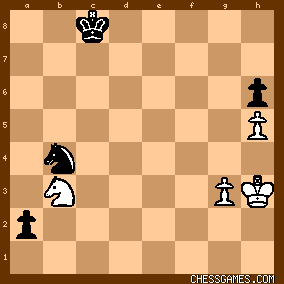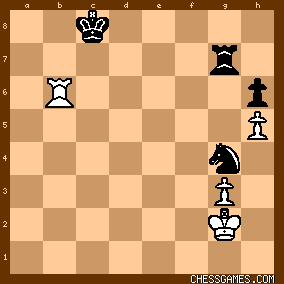|
< Earlier Kibitzing · PAGE 2 OF 2 ·
Later Kibitzing> |
| Mar-16-04 | | Calli: <meloncio> Is that Alekhine's book, "On the Road ...." ? It was finally published in English in the 1980's. Unfortunately, it is out of print now and I never did pick up a copy. |
|
Mar-17-04
 | | Benzol: <Calli> Yes, it is "On the Road...." One of these days I must get down to having a decent look at it. |
|
| Mar-17-04 | | artemis: I like Alekhines play of 11. Ne4. It reminds me of a game he played against yates in 1922. why give up exchanges to a cramped opponent? |
|
| Mar-17-04 | | meloncio: <Calli> No. My book is Argentinian published in 1977, 50º anniversary of the match. It's very interesting because there is a lot of eye-witness statements. For instance, Capa had many fans and friends; however Alekhine was always alone, just with her wife. |
|
| Mar-17-04 | | Calli: <meloncio> Very interesting. Of course, Capa had been to Buenos Aires many times and was popular there. I think that would be Alekhine's third wife. She sometimes gets credit for AA's improvement around 1925-1930. |
|
Aug-30-05
 | | offramp: Alekhine says he took 1 hour and 50 minutes over his sealed move, 41.Nef4. I don't quite get that. I thought the time control was 40 moves in 2½ hours, then 16 moves in every subsequent hour, so that the next time control was at move 56. So Alekhine must have had at least 51 minutes remaining from the first session. If that is the case it is no wonder he ran into trouble. |
|
Aug-30-05
 | | offramp: I think Capablanca was wrong to offer a draw.
After 43.g3 Rxb4 44.Kh3 Ra4 looks like a killer move. Where does the rook move to? I don't think white can exchange rooks: 45.Rxa4 bxa4 46.Nd3 a3 47.Nc1 Na6 48.Na2 Nc5 49.g4 Nd3 50.Kg3 Ncxe5 51.Nxe5 Nxe5 etc etc. I would appreciate your thought because it looks like another missed win for Capablanca. |
|
| Aug-30-05 | | Boomie: <offramp> AA would have played Nf8 before Kh3. Even though I'm finding wins for black after Rxb4, I'm sure that both Capa and AA found the drawing line. White gets strong couterplay through the attack on e6, as AA mentioned. However I have to agree with <Calli> that Capa should play on here. The lines following are so long that he has to give it a shot. This is a nice study in R+N endgames with many fine nuances. I'm sorry they didn't play it out so we could have their ideas. The student would do well to study this position. 43. g3 Rxb4 44. Nf8 Nxe5+ 45. Kh3 Rc4
(45...Ra4 46. N8xe6+ Nxe6 47. Nxe6+ Ke8 48. Nxg7+ Kd8 49. Ne6+  (0.52/15)) (0.52/15)) 46. N8xe6+ Kc8 47. Nxc7 Rxc7 48. Ra5 Rc5
(48...Rb7 49. Ne6 Nd3 50. Ra3 Nf2+ 51. Kg2 Ne4 52. Re3 Nd2 53. Rc3+ Kb8 54. Nd4 Ka7 55. Rc2 Ne4 56. Kf3 (56. g4 Kb6 57. Kf3 Re7
(57...Nf6 58. Rc6+ Ka5 59. Rc5 Ka4 60. g5  (0.61/14)) (0.61/14)) 58. Rc6+
(58. Nf5 Ng5+ 59. Kf4 Re4+ 60. Kg3 Ne6 61. Kf3 Re5 62. Rb2 Kc5  (-1.45/14)) (-1.45/14)) 58...Ka5 59. Rg6 Nd2+ 60. Kf2-/= (-1.27/14)))
49. Ne6
(49. Ra8+ Kb7 50. Rg8 Rc7 51. Re8 Nc6  (-1.75/15)) (-1.75/15))
49...Nc4 50. Ra8+ Kb7 51. Nxc5+ Kxa8 52. Kg4 Ka7  (-1.05/17) (-1.05/17) (52...b4 53. Kf5 Ka7 54. Kg6 Ne5+ 55. Kxg7 Kb6 56. Nb3 Ng4 57. Kg6 Kb5 58. Kf5=) |
|
Aug-31-05
 | | offramp: Here is the variation that Alekhine gave:
43.g3 Ne3+
( 43...Rxb4 44.Nf8 Nxe5+ 45.Kh3 Rc4 46.N8xe6+ Kc8 47.Nxg7 Ra4 48.Rxa4 bxa4 49.Ne2 a3 50.Nc3 Nd5 51.Na2 Nd3 52.Nf5 N5b4 53.Nxb4 Nxb4 54.Nd4 a2 55.Nb3 Kd7 56.g4 Ke6 57.g5 hxg5 58.h6 Kf6 59.h7 Kg7 60.Kg4=) 44.Kh3 Nf5 45.Nf8 Nd4 46.Rb7 Kc8
( 46...Rxb4? 47.Rb8+ Ke7 48.N4g6+ Kf7 49.Nh7 Ne8 50.Rb7+ Kg8 51.Re7 Nc7 52.Nf6+ gxf6 53.exf6 Nf5 54.f7+ Kh7 55.f8Q+ Nxe7 56.Qf7#) 47.Rb6=
There are probably holes in it. |
|
| Aug-31-05 | | Boomie: <offramp> Thanks for adding AA's analysis. My/Fritz analysis diverges from his at move 47, where AA gives ♘xg7. This loses however. 47. ♘xg7 ♖a4 48. ♖xa4 bxa4 49. ♘e2 ♘d5 50. ♘f5 ♘f7 51. ♘c1 ♔d7 52. g4 ♔e6 53. ♔g3 ♘e7 54. ♔f4 ♘xf5 55. gxf5+ ♔d5 56. ♔e3 ♔e5  (-2.26/18) (-2.26/18) |
|
| Mar-03-08 | | Knight13: Let's just call it a "Grandmaster Draw Offer." |
|
| Mar-04-08 | | Whitehat1963: So what do Rybka and Zappa think of the ending position? |
|
| Apr-07-11 | | bronkenstein: Rybka or Fritz will , naturally , deviate from positions in which white sacs his knight or even two for the remaining black pawns , delaying it untill it´s too late . Typical example of engines being unable to ´understand´ some basic strategical concepts that 5 y old kid could grasp , therefore neither of them is good tool for judging the ending position . To have your answer , you would need a master or GM with high endgame technique , to lead the computer through + use Nalimov tablebase when number of pieces drops eventually . IMO both Capa and AA saw clear ways for white to draw , especially having in mind the amount of time they spent on it, and the sport importance of the game. Capa wouldn´t embarass himself by what is common for today´s top GMs , trying to win a drawn ending by exhausting his opponnent or waiting for simple mistake in 7th hour of the game, including basic R+B vs R and similar ... especially knowing who he was playing against. |
|
Sep-02-11
 | | kingscrusher: Okay what is the matter with *both* players - why was this boring Ne4 line repeated over and over again in this match?! |
|
| Nov-19-12 | | koleos: Please anybody to explain why Capa offered draw here ? After 43)...Rb4,44)...Ra4, black is winning. What is the 44) "magic move" for white to escape defeat ? |
|
Nov-19-12
 | | keypusher: <koleos: Please anybody to explain why Capa offered draw here ? After 43)...Rb4,44)...Ra4, black is winning. What is the 44) "magic move" for white to escape defeat ?> There is a lot of analysis posted on this page about that move. You might want to look at it and see if you still have questions. |
|
Nov-19-12
 | | maxi: The Capablanca-Alekhine WCh is full of blunders, particularly in the endgame. So I cannot believe that simply Capa analyzed the position, saw a drawing line, and took for granted that Alekhine would have found it. Evidently Capa was not in the appropriate frame of mind for this match. His repeated use of openings that gave Alekhine no trouble, his taking of draws in better positions, and, in general, his timid attitude are symptoms that something was not right. Of course, in this game he should have tortured Alekhine a while longer! But he was not quite his usual self. And Alekhine was playing wonderfully. |
|
| Nov-20-12 | | aliejin: Capablanco said after the match, both players
had played very well, especially endgames ......
Capablanca had, from very young, the habit of repeating
openings, when this opening guaranteed him a quiet game ..
because he deposited all his hope in the middle game and especially
at the endgame ...
In the match with Alekhine, Capablanca did what he always did .... Capablanca was not in bad shape ( on the contrary ) ... Alekhine put him
this situation |
|
| Nov-20-12 | | brankat: <allejin> <Capablanca was not in bad shape ( on the contrary ) ... Alekhine put him this situation.> Precisely. |
|
Nov-20-12
 | | maxi: Well, I am not going to argue if Alekhine put him in a bad psych position, perhaps that is so. But it is wholly incorrect to say that Capa repeated his openings. On the contrary, throughout his life he tended to vary his openings, especially the secondary lines. And he wrote so several times, to the effect of "I played that move just to avoid the usual lines" and similar phrases. His tendency to play secondary lines in the openings was, IMO, another trait that make him so dangerous. Like Petrosian and Lasker he would not play the "best" line and thus much of home preparation of his opponent would go down the drain. During a tournament he usually stuck to a line, but he would change it next time he played in another tournament. A possible reason for this habit is that he thought that his theoretical knowledge was inferior and wanted to avoid theoretical surprises. At any rate my point precisely is that the only time in his life (that I am aware of) he broke with this tradition and kept playing the same thing over and over again was during his match with Alekhine. |
|
Nov-20-12
 | | maxi: The endings may have been good, or excellent perhaps, but still they are full of blunders. I won't bore people with my analysis, for it is not necessary: we have many reviews by the players themselves and by other GMs and experts who point to this fact. |
|
| Nov-20-12 | | aliejin: "The endings may have been good, or excellent perhaps, but still they are full of blunders" I'm sorry but this is unsound
by it self
Capablanca used to repeat "planteos"
( may be "openning" is not the right
word , english is not my native language ) as Panov explained in
his book "Capablanca"
Especially when was insecure , i would add |
|
| Dec-02-13 | | Owl: If you win a passed pawn and the game is a draw and your losing a world championship match. You should still play it out.
But the game is a draw especially against Alekhine |
|
Apr-17-19
 | | woldsmandriffield: It is extraordinary that Capablanca did not play the game out especially if it was adjourned around the final position. 43 g3 was the best move. Alekine subsequently published the following sequence 43..Rxb4 44 Nf8 Nxe5 45 Kh3 Rc4 46 N8xe6 Kc8 47 Nxg7 Ra4 48 Rxa4 bxa4 49 Ne2 a3 50 Nc3 Nd5 51 Na2 Nd3 52 Nf5 N5b4 53 Nxb4 Nxb4 54 Nd4 a2 55 Nb3 
click for larger viewNow Alekhine gives 55..Kd7 56 g4 Ke6 57 g5 hxg5 58 h6 Kf6 59 h7! Kg7 60 Kg4 = But Black can improve with 55..Nc2 56 g4 Nd4 57 Na1 Ne6 -+ Instead of the rash 47 Nxg7 White may be able to draw with 47 Nxc7 Rxa7 48 Ra5 Rb7 49 Ne6 Nd3 50 Nxg7! Rxg7 51 Rxb5 Nf2+ 52 Kg2 Ng4 53 Rb6 
click for larger viewFor example, 53..Kc7 54 Ra6 Rg8 55 Kf3 Ne5+ 56 Kf4 Nc6 57 g4 Rf8+ 58 Ke4 Kd6 59 Rb6 Kc5 60 Rb7 and it looks like White will eliminate the final Black pawn and be able to defend R+N vs R. |
|
Apr-17-19
 | | perfidious: <kingscrusher: Okay what is the matter with *both* players - why was this boring Ne4 line repeated over and over again in this match?!> The answer to that question is irresoluble, though Golombek's comment to the effect that after playing through the games of this match, one tended to wish the Orthodox QGD had never been invented was delicious. |
|
 |
|
< Earlier Kibitzing · PAGE 2 OF 2 ·
Later Kibitzing> |





